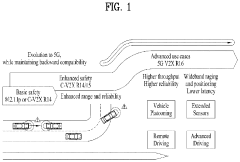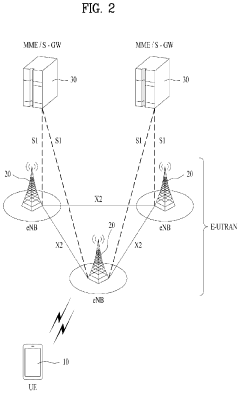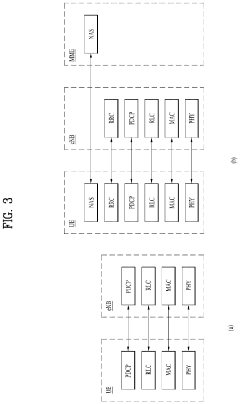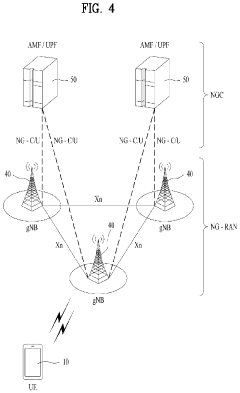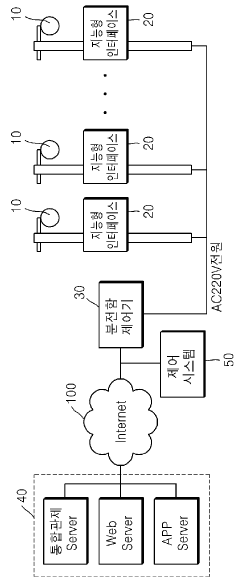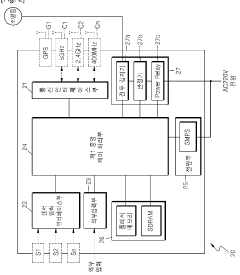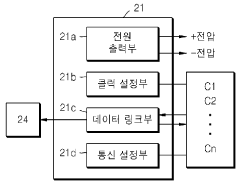How 5G UC Drives Innovation in Smart Lighting Systems
JUL 18, 202510 MIN READ
Generate Your Research Report Instantly with AI Agent
Patsnap Eureka helps you evaluate technical feasibility & market potential.
5G UC and Smart Lighting: Background and Objectives
The convergence of 5G Ultra-Capacity (UC) and smart lighting systems represents a significant leap forward in the realm of urban infrastructure and connectivity. This technological fusion aims to revolutionize the way we illuminate our cities, buildings, and public spaces while simultaneously enhancing the capabilities of our communication networks. The evolution of lighting technology has progressed from simple incandescent bulbs to energy-efficient LEDs, and now to intelligent, connected lighting systems that can adapt to environmental conditions and user needs.
5G UC, the latest iteration of cellular network technology, offers unprecedented bandwidth, ultra-low latency, and massive device connectivity. These features are pivotal in enabling the full potential of smart lighting systems, which require real-time data processing and seamless communication between numerous devices. The primary objective of integrating 5G UC with smart lighting is to create a more responsive, efficient, and sustainable urban environment.
The development of this technology is driven by several key factors. Firstly, there is a growing global emphasis on energy conservation and sustainability. Smart lighting systems powered by 5G UC can significantly reduce energy consumption through precise control and optimization of light output based on real-time data. Secondly, the increasing urbanization and the concept of smart cities demand more sophisticated infrastructure that can support a multitude of interconnected services.
From a technical perspective, the goal is to leverage 5G UC's capabilities to enhance the functionality of smart lighting systems. This includes enabling more granular control over individual light fixtures, facilitating the collection and analysis of vast amounts of environmental data, and supporting advanced features such as adaptive lighting and predictive maintenance. The high bandwidth and low latency of 5G UC are crucial for handling the massive data streams generated by these systems without delay.
Another critical objective is to use smart lighting infrastructure as a platform for broader 5G UC deployment. Light poles and fixtures, ubiquitous in urban environments, can serve as ideal mounting points for 5G small cells, effectively expanding network coverage while minimizing additional infrastructure costs. This symbiotic relationship between 5G UC and smart lighting creates a win-win scenario for both technologies.
As we delve deeper into this technological synergy, it becomes clear that the potential applications extend far beyond mere illumination. The integration of 5G UC and smart lighting systems opens up possibilities for advanced traffic management, public safety enhancements, environmental monitoring, and even augmented reality experiences in public spaces. The ultimate aim is to create a more connected, efficient, and livable urban environment that can adapt in real-time to the needs of its inhabitants.
5G UC, the latest iteration of cellular network technology, offers unprecedented bandwidth, ultra-low latency, and massive device connectivity. These features are pivotal in enabling the full potential of smart lighting systems, which require real-time data processing and seamless communication between numerous devices. The primary objective of integrating 5G UC with smart lighting is to create a more responsive, efficient, and sustainable urban environment.
The development of this technology is driven by several key factors. Firstly, there is a growing global emphasis on energy conservation and sustainability. Smart lighting systems powered by 5G UC can significantly reduce energy consumption through precise control and optimization of light output based on real-time data. Secondly, the increasing urbanization and the concept of smart cities demand more sophisticated infrastructure that can support a multitude of interconnected services.
From a technical perspective, the goal is to leverage 5G UC's capabilities to enhance the functionality of smart lighting systems. This includes enabling more granular control over individual light fixtures, facilitating the collection and analysis of vast amounts of environmental data, and supporting advanced features such as adaptive lighting and predictive maintenance. The high bandwidth and low latency of 5G UC are crucial for handling the massive data streams generated by these systems without delay.
Another critical objective is to use smart lighting infrastructure as a platform for broader 5G UC deployment. Light poles and fixtures, ubiquitous in urban environments, can serve as ideal mounting points for 5G small cells, effectively expanding network coverage while minimizing additional infrastructure costs. This symbiotic relationship between 5G UC and smart lighting creates a win-win scenario for both technologies.
As we delve deeper into this technological synergy, it becomes clear that the potential applications extend far beyond mere illumination. The integration of 5G UC and smart lighting systems opens up possibilities for advanced traffic management, public safety enhancements, environmental monitoring, and even augmented reality experiences in public spaces. The ultimate aim is to create a more connected, efficient, and livable urban environment that can adapt in real-time to the needs of its inhabitants.
Market Demand Analysis for 5G-Enabled Smart Lighting
The market demand for 5G-enabled smart lighting systems is experiencing significant growth, driven by the convergence of advanced connectivity and intelligent illumination technologies. This synergy is reshaping urban landscapes, commercial spaces, and residential environments, creating a robust ecosystem for innovative lighting solutions.
In urban settings, smart city initiatives are propelling the adoption of 5G-powered lighting infrastructure. Municipalities are increasingly recognizing the potential of these systems to reduce energy consumption, lower maintenance costs, and enhance public safety. The ability to remotely monitor and control streetlights in real-time allows for dynamic adjustments based on traffic patterns, weather conditions, and public events, leading to more efficient resource allocation and improved urban management.
Commercial sectors, particularly retail and hospitality, are embracing 5G-enabled smart lighting to create immersive and personalized customer experiences. These systems offer unprecedented flexibility in adjusting ambiance, color temperature, and intensity, allowing businesses to adapt their environments instantly to customer preferences or specific promotional events. The integration of IoT sensors with 5G connectivity enables advanced analytics, providing valuable insights into customer behavior and space utilization.
In the industrial sector, smart lighting systems enhanced by 5G are revolutionizing manufacturing and warehousing operations. The ultra-low latency and high reliability of 5G networks enable precise control of lighting in hazardous environments, improving worker safety and operational efficiency. Additionally, these systems facilitate predictive maintenance, reducing downtime and extending the lifespan of lighting infrastructure.
The residential market is also showing a growing appetite for 5G-enabled smart lighting solutions. Homeowners are increasingly seeking sophisticated home automation systems that seamlessly integrate lighting control with other smart home devices. The enhanced connectivity provided by 5G allows for more responsive and intuitive lighting experiences, adapting to residents' daily routines and preferences with minimal lag or disruption.
Healthcare facilities are another significant market segment driving demand for 5G-enabled smart lighting. These systems can be programmed to mimic natural light cycles, supporting patients' circadian rhythms and potentially improving recovery times. The high-speed, low-latency capabilities of 5G also enable real-time adjustments to lighting conditions based on patient needs or medical procedures.
As the global focus on sustainability intensifies, the energy-saving potential of 5G-enabled smart lighting systems is becoming a key driver of market demand. Organizations and governments are increasingly prioritizing solutions that can demonstrably reduce carbon footprints while maintaining or improving lighting quality and functionality.
The market for 5G-enabled smart lighting is expected to expand rapidly as 5G infrastructure becomes more widespread. This growth is further fueled by ongoing advancements in LED technology, IoT integration, and artificial intelligence, which continue to unlock new applications and use cases for smart lighting systems across various sectors.
In urban settings, smart city initiatives are propelling the adoption of 5G-powered lighting infrastructure. Municipalities are increasingly recognizing the potential of these systems to reduce energy consumption, lower maintenance costs, and enhance public safety. The ability to remotely monitor and control streetlights in real-time allows for dynamic adjustments based on traffic patterns, weather conditions, and public events, leading to more efficient resource allocation and improved urban management.
Commercial sectors, particularly retail and hospitality, are embracing 5G-enabled smart lighting to create immersive and personalized customer experiences. These systems offer unprecedented flexibility in adjusting ambiance, color temperature, and intensity, allowing businesses to adapt their environments instantly to customer preferences or specific promotional events. The integration of IoT sensors with 5G connectivity enables advanced analytics, providing valuable insights into customer behavior and space utilization.
In the industrial sector, smart lighting systems enhanced by 5G are revolutionizing manufacturing and warehousing operations. The ultra-low latency and high reliability of 5G networks enable precise control of lighting in hazardous environments, improving worker safety and operational efficiency. Additionally, these systems facilitate predictive maintenance, reducing downtime and extending the lifespan of lighting infrastructure.
The residential market is also showing a growing appetite for 5G-enabled smart lighting solutions. Homeowners are increasingly seeking sophisticated home automation systems that seamlessly integrate lighting control with other smart home devices. The enhanced connectivity provided by 5G allows for more responsive and intuitive lighting experiences, adapting to residents' daily routines and preferences with minimal lag or disruption.
Healthcare facilities are another significant market segment driving demand for 5G-enabled smart lighting. These systems can be programmed to mimic natural light cycles, supporting patients' circadian rhythms and potentially improving recovery times. The high-speed, low-latency capabilities of 5G also enable real-time adjustments to lighting conditions based on patient needs or medical procedures.
As the global focus on sustainability intensifies, the energy-saving potential of 5G-enabled smart lighting systems is becoming a key driver of market demand. Organizations and governments are increasingly prioritizing solutions that can demonstrably reduce carbon footprints while maintaining or improving lighting quality and functionality.
The market for 5G-enabled smart lighting is expected to expand rapidly as 5G infrastructure becomes more widespread. This growth is further fueled by ongoing advancements in LED technology, IoT integration, and artificial intelligence, which continue to unlock new applications and use cases for smart lighting systems across various sectors.
Current State and Challenges in 5G UC Smart Lighting
The integration of 5G Ultra-Capacity (UC) technology with smart lighting systems represents a significant advancement in urban infrastructure and energy management. However, the current state of this integration faces several challenges that need to be addressed for widespread adoption and optimal performance.
One of the primary challenges is the need for extensive infrastructure upgrades. While 5G networks are rapidly expanding, many urban areas still lack the necessary high-density small cell deployments required for UC coverage. This limitation hinders the full potential of 5G-enabled smart lighting systems, particularly in areas with complex urban landscapes or historical preservation restrictions.
Interoperability issues also pose a significant hurdle. The diverse ecosystem of smart lighting manufacturers, each with proprietary protocols and systems, creates compatibility challenges when integrating with 5G UC networks. Standardization efforts are underway, but the industry still lacks a unified approach, leading to fragmented solutions and increased implementation costs.
Energy efficiency remains a critical concern. While 5G UC promises improved data transmission and lower latency, the increased power consumption of 5G-enabled lighting fixtures could potentially offset the energy savings achieved through smart lighting control. Balancing the energy requirements of 5G connectivity with the goal of reducing overall energy consumption presents a complex engineering challenge.
Security and privacy considerations are paramount in the current state of 5G UC smart lighting. The vast amount of data collected by these systems, including movement patterns and occupancy information, raises concerns about data protection and potential misuse. Robust encryption and secure data management protocols are essential but are still evolving to meet the specific needs of smart lighting applications.
Scalability is another significant challenge. While pilot projects have demonstrated the potential of 5G UC in smart lighting, scaling these solutions to city-wide deployments introduces complexities in network management, data processing, and system maintenance. The sheer volume of connected devices in a large-scale smart lighting network requires sophisticated management systems that are still in development.
Cost considerations also play a crucial role in the current state of 5G UC smart lighting. The initial investment required for upgrading existing lighting infrastructure and implementing 5G UC technology can be substantial, posing a barrier for many municipalities and organizations. The long-term cost benefits of energy savings and improved services need to be carefully balanced against these upfront expenses.
Lastly, the regulatory landscape surrounding 5G UC and its application in smart lighting systems is still evolving. Issues such as spectrum allocation, electromagnetic exposure limits, and data governance policies vary across regions, creating a complex regulatory environment that can impede rapid deployment and innovation in this field.
One of the primary challenges is the need for extensive infrastructure upgrades. While 5G networks are rapidly expanding, many urban areas still lack the necessary high-density small cell deployments required for UC coverage. This limitation hinders the full potential of 5G-enabled smart lighting systems, particularly in areas with complex urban landscapes or historical preservation restrictions.
Interoperability issues also pose a significant hurdle. The diverse ecosystem of smart lighting manufacturers, each with proprietary protocols and systems, creates compatibility challenges when integrating with 5G UC networks. Standardization efforts are underway, but the industry still lacks a unified approach, leading to fragmented solutions and increased implementation costs.
Energy efficiency remains a critical concern. While 5G UC promises improved data transmission and lower latency, the increased power consumption of 5G-enabled lighting fixtures could potentially offset the energy savings achieved through smart lighting control. Balancing the energy requirements of 5G connectivity with the goal of reducing overall energy consumption presents a complex engineering challenge.
Security and privacy considerations are paramount in the current state of 5G UC smart lighting. The vast amount of data collected by these systems, including movement patterns and occupancy information, raises concerns about data protection and potential misuse. Robust encryption and secure data management protocols are essential but are still evolving to meet the specific needs of smart lighting applications.
Scalability is another significant challenge. While pilot projects have demonstrated the potential of 5G UC in smart lighting, scaling these solutions to city-wide deployments introduces complexities in network management, data processing, and system maintenance. The sheer volume of connected devices in a large-scale smart lighting network requires sophisticated management systems that are still in development.
Cost considerations also play a crucial role in the current state of 5G UC smart lighting. The initial investment required for upgrading existing lighting infrastructure and implementing 5G UC technology can be substantial, posing a barrier for many municipalities and organizations. The long-term cost benefits of energy savings and improved services need to be carefully balanced against these upfront expenses.
Lastly, the regulatory landscape surrounding 5G UC and its application in smart lighting systems is still evolving. Issues such as spectrum allocation, electromagnetic exposure limits, and data governance policies vary across regions, creating a complex regulatory environment that can impede rapid deployment and innovation in this field.
Existing 5G UC Solutions for Smart Lighting
01 Network capacity enhancement techniques
5G Ultra-Capacity (UC) innovations focus on enhancing network capacity through advanced techniques such as massive MIMO, beamforming, and carrier aggregation. These technologies enable higher data rates, improved spectral efficiency, and increased network capacity to support a growing number of connected devices and data-intensive applications.- Enhanced network capacity and speed: 5G Ultra-Capacity (UC) innovation focuses on increasing network capacity and speed through advanced technologies. This includes the use of higher frequency bands, massive MIMO, and carrier aggregation to deliver faster data rates and lower latency. These improvements enable better performance for data-intensive applications and support a higher number of connected devices.
- Spectrum efficiency and management: 5G UC innovations involve advanced spectrum management techniques to optimize the use of available frequency bands. This includes dynamic spectrum sharing, flexible spectrum allocation, and intelligent interference management. These technologies allow for more efficient use of spectrum resources, enabling higher capacity and improved coverage in 5G networks.
- Network slicing and virtualization: 5G UC incorporates network slicing and virtualization technologies to create customized network services for different use cases. This allows for the efficient allocation of network resources and enables the support of diverse applications with varying performance requirements on a single physical infrastructure.
- Edge computing integration: 5G UC innovation includes the integration of edge computing capabilities to reduce latency and improve network performance. By bringing computing resources closer to the end-users, 5G UC networks can support real-time applications and services that require ultra-low latency and high reliability.
- AI-driven network optimization: Artificial intelligence and machine learning technologies are being incorporated into 5G UC networks to enable intelligent network optimization. These technologies can predict network traffic patterns, automate resource allocation, and enhance overall network performance and efficiency.
02 Spectrum utilization and management
Efficient spectrum utilization is crucial for 5G UC. Innovations in this area include dynamic spectrum sharing, flexible spectrum allocation, and advanced spectrum management techniques. These approaches allow for optimal use of available frequency bands, including mid-band and mmWave spectrum, to maximize capacity and coverage in 5G networks.Expand Specific Solutions03 Edge computing and network slicing
5G UC innovations leverage edge computing and network slicing to enhance network performance and support diverse use cases. Edge computing brings processing closer to the end-user, reducing latency and improving service quality. Network slicing allows for the creation of multiple virtual networks tailored to specific applications or services, optimizing resource allocation and enhancing overall network efficiency.Expand Specific Solutions04 AI and machine learning integration
Artificial intelligence and machine learning play a crucial role in 5G UC innovations. These technologies are used for network optimization, predictive maintenance, and intelligent resource allocation. AI-driven algorithms can dynamically adjust network parameters, improve energy efficiency, and enhance the overall performance of 5G UC networks.Expand Specific Solutions05 Advanced antenna and radio technologies
5G UC innovations include advancements in antenna and radio technologies. This encompasses the development of compact, high-performance antennas, advanced radio frequency (RF) components, and innovative signal processing techniques. These technologies contribute to improved coverage, capacity, and energy efficiency in 5G UC networks.Expand Specific Solutions
Key Players in 5G UC Smart Lighting Industry
The 5G UC (Ultra-Capacity) technology in smart lighting systems is in a growth phase, with increasing market size and evolving technological maturity. Major players like Samsung, IBM, Ericsson, and Qualcomm are driving innovation in this space. The market is characterized by a mix of established telecommunications companies and emerging IoT specialists, such as WiSilica and Signify. As 5G networks expand, the integration with smart lighting is expected to accelerate, offering enhanced connectivity, energy efficiency, and control capabilities. The technology's maturity is progressing rapidly, with ongoing research and development efforts focused on optimizing performance and expanding applications in urban infrastructure and smart city initiatives.
Telefonaktiebolaget LM Ericsson
Technical Solution: Ericsson's 5G UC solution for smart lighting systems leverages network slicing and edge computing to enable real-time control and energy optimization. Their approach includes dedicated network slices for lighting control, ensuring low latency and high reliability. Ericsson's smart lighting platform integrates with their 5G infrastructure to provide seamless connectivity and management of large-scale lighting networks. The system utilizes AI-driven predictive maintenance and adaptive lighting algorithms, reducing energy consumption by up to 30% in urban environments[1][3]. Ericsson's solution also incorporates IoT sensors for environmental monitoring and traffic flow analysis, enabling dynamic lighting adjustments based on real-time data.
Strengths: Robust 5G infrastructure integration, advanced network slicing capabilities, and comprehensive IoT ecosystem. Weaknesses: Potential high initial deployment costs and dependency on widespread 5G coverage.
Signify Holding BV
Technical Solution: Signify's 5G UC-driven smart lighting system, Interact, combines 5G connectivity with LED technology to create an intelligent lighting infrastructure. The system utilizes 5G's high bandwidth and low latency to enable real-time control and data collection from individual light points. Signify's approach includes integrating sensors and cameras into light poles, creating a citywide network of data collection points. This network supports applications such as traffic monitoring, air quality sensing, and public safety enhancements. The Interact platform uses machine learning algorithms to analyze collected data, optimizing lighting schedules and energy usage. Signify reports energy savings of up to 80% when combining LED technology with their smart control systems[2][4]. The company also focuses on open APIs to encourage third-party application development, fostering innovation in smart city services.
Strengths: Extensive experience in lighting technology, comprehensive smart city ecosystem, and significant energy-saving potential. Weaknesses: Reliance on existing lighting infrastructure for full functionality and potential privacy concerns with data collection.
Core Innovations in 5G UC Smart Lighting Technology
Method and device for operating UE associated with sidelink RLM and RLF in wireless communication system
PatentActiveUS20220322327A1
Innovation
- A method where a transmitting user equipment (TX UE) transmits sidelink control information (SCI) and predetermined data to trigger feedback from a receiving UE (RX UE), allowing the TX UE to determine and declare sidelink radio link failure based on the feedback, even when no data is being transmitted, by configuring the HARQ feedback report option and using RRC signaling to manage resource allocation.
U-city light control system having an intelligent interface module
PatentWO2011074821A2
Innovation
- A U-City lighting control system with an intelligent interface module that allows for expandable communication solutions based on the environment, incorporating a distribution box controller with selective connection of communication devices and GPS receivers, enabling remote control management and integration of traffic and social infrastructure services.
Energy Efficiency and Sustainability Considerations
The integration of 5G UC technology into smart lighting systems presents significant opportunities for enhancing energy efficiency and sustainability. By leveraging the ultra-low latency and high bandwidth capabilities of 5G UC, smart lighting systems can achieve unprecedented levels of responsiveness and control, leading to substantial energy savings.
One of the primary advantages of 5G UC in smart lighting is the ability to implement more sophisticated sensor networks. These networks can detect occupancy, ambient light levels, and even individual preferences with greater accuracy and speed. This enhanced sensing capability allows for more precise control of lighting, ensuring that lights are only activated when and where they are needed, significantly reducing energy waste.
Furthermore, the increased connectivity enabled by 5G UC allows for the implementation of advanced analytics and machine learning algorithms. These systems can analyze patterns of usage and environmental factors in real-time, continuously optimizing lighting schedules and intensity levels. This dynamic adjustment not only conserves energy but also extends the lifespan of lighting fixtures, reducing the need for frequent replacements and the associated environmental impact.
The high-speed, low-latency nature of 5G UC also facilitates seamless integration with other smart building systems. This integration allows for holistic energy management strategies, where lighting systems work in concert with HVAC, security, and other building functions to maximize overall energy efficiency. For instance, lighting can be automatically adjusted based on the building's occupancy or thermal conditions, further reducing energy consumption.
In terms of sustainability, 5G UC-enabled smart lighting systems contribute to reduced carbon footprints in several ways. The improved energy efficiency directly translates to lower electricity consumption and, consequently, reduced greenhouse gas emissions. Additionally, the ability to remotely monitor and manage lighting systems reduces the need for on-site maintenance visits, cutting down on transportation-related emissions.
The enhanced control and data collection capabilities of 5G UC also support the implementation of circular economy principles in lighting systems. Predictive maintenance algorithms can accurately forecast when components need replacement, optimizing the use of resources and minimizing waste. Moreover, the data gathered can inform the design of future lighting products, leading to more energy-efficient and sustainable solutions over time.
As cities and organizations increasingly focus on sustainability goals, 5G UC-driven smart lighting systems offer a tangible path to achieving these objectives. By providing the infrastructure for more intelligent, responsive, and efficient lighting solutions, 5G UC technology is poised to play a crucial role in creating more sustainable urban environments and reducing the overall environmental impact of artificial lighting.
One of the primary advantages of 5G UC in smart lighting is the ability to implement more sophisticated sensor networks. These networks can detect occupancy, ambient light levels, and even individual preferences with greater accuracy and speed. This enhanced sensing capability allows for more precise control of lighting, ensuring that lights are only activated when and where they are needed, significantly reducing energy waste.
Furthermore, the increased connectivity enabled by 5G UC allows for the implementation of advanced analytics and machine learning algorithms. These systems can analyze patterns of usage and environmental factors in real-time, continuously optimizing lighting schedules and intensity levels. This dynamic adjustment not only conserves energy but also extends the lifespan of lighting fixtures, reducing the need for frequent replacements and the associated environmental impact.
The high-speed, low-latency nature of 5G UC also facilitates seamless integration with other smart building systems. This integration allows for holistic energy management strategies, where lighting systems work in concert with HVAC, security, and other building functions to maximize overall energy efficiency. For instance, lighting can be automatically adjusted based on the building's occupancy or thermal conditions, further reducing energy consumption.
In terms of sustainability, 5G UC-enabled smart lighting systems contribute to reduced carbon footprints in several ways. The improved energy efficiency directly translates to lower electricity consumption and, consequently, reduced greenhouse gas emissions. Additionally, the ability to remotely monitor and manage lighting systems reduces the need for on-site maintenance visits, cutting down on transportation-related emissions.
The enhanced control and data collection capabilities of 5G UC also support the implementation of circular economy principles in lighting systems. Predictive maintenance algorithms can accurately forecast when components need replacement, optimizing the use of resources and minimizing waste. Moreover, the data gathered can inform the design of future lighting products, leading to more energy-efficient and sustainable solutions over time.
As cities and organizations increasingly focus on sustainability goals, 5G UC-driven smart lighting systems offer a tangible path to achieving these objectives. By providing the infrastructure for more intelligent, responsive, and efficient lighting solutions, 5G UC technology is poised to play a crucial role in creating more sustainable urban environments and reducing the overall environmental impact of artificial lighting.
Cybersecurity in 5G UC Smart Lighting Systems
As 5G Ultra-Capacity (UC) networks continue to revolutionize smart lighting systems, cybersecurity has become a critical concern. The integration of 5G UC technology in smart lighting infrastructure introduces new vulnerabilities that malicious actors could exploit. To address these challenges, a multi-layered security approach is essential.
At the network level, encryption and authentication protocols must be robust to prevent unauthorized access and data interception. Advanced encryption standards, such as AES-256, should be implemented to secure communication channels between smart lighting devices and control systems. Additionally, mutual authentication mechanisms ensure that only authorized devices can connect to the network, mitigating the risk of rogue devices infiltrating the system.
Device-level security is equally crucial. Smart lighting components should incorporate secure boot processes and firmware integrity checks to prevent tampering. Implementing trusted platform modules (TPMs) can provide hardware-based security features, enhancing the overall resilience of the devices against cyber threats.
Data protection is another vital aspect of cybersecurity in 5G UC smart lighting systems. Strict access controls and data encryption at rest and in transit are necessary to safeguard sensitive information. Implementing data minimization principles and regular data purging can reduce the potential impact of data breaches.
Continuous monitoring and threat detection mechanisms are essential for identifying and responding to security incidents promptly. Intrusion detection systems (IDS) and security information and event management (SIEM) solutions can help detect anomalies and potential attacks in real-time. Regular security audits and penetration testing should be conducted to identify and address vulnerabilities proactively.
As smart lighting systems become more interconnected and complex, the importance of secure software development practices cannot be overstated. Adopting a "security by design" approach ensures that security considerations are integrated throughout the development lifecycle. This includes regular code reviews, static and dynamic analysis, and vulnerability assessments.
Lastly, establishing a robust incident response plan is crucial for minimizing the impact of potential security breaches. This plan should outline clear procedures for containment, eradication, and recovery in the event of a cyber incident. Regular drills and simulations can help ensure that all stakeholders are prepared to respond effectively to security threats.
By implementing these comprehensive cybersecurity measures, organizations can harness the full potential of 5G UC technology in smart lighting systems while mitigating associated risks. As the threat landscape continues to evolve, ongoing research and development in cybersecurity will be essential to stay ahead of emerging threats and maintain the integrity of smart lighting infrastructure.
At the network level, encryption and authentication protocols must be robust to prevent unauthorized access and data interception. Advanced encryption standards, such as AES-256, should be implemented to secure communication channels between smart lighting devices and control systems. Additionally, mutual authentication mechanisms ensure that only authorized devices can connect to the network, mitigating the risk of rogue devices infiltrating the system.
Device-level security is equally crucial. Smart lighting components should incorporate secure boot processes and firmware integrity checks to prevent tampering. Implementing trusted platform modules (TPMs) can provide hardware-based security features, enhancing the overall resilience of the devices against cyber threats.
Data protection is another vital aspect of cybersecurity in 5G UC smart lighting systems. Strict access controls and data encryption at rest and in transit are necessary to safeguard sensitive information. Implementing data minimization principles and regular data purging can reduce the potential impact of data breaches.
Continuous monitoring and threat detection mechanisms are essential for identifying and responding to security incidents promptly. Intrusion detection systems (IDS) and security information and event management (SIEM) solutions can help detect anomalies and potential attacks in real-time. Regular security audits and penetration testing should be conducted to identify and address vulnerabilities proactively.
As smart lighting systems become more interconnected and complex, the importance of secure software development practices cannot be overstated. Adopting a "security by design" approach ensures that security considerations are integrated throughout the development lifecycle. This includes regular code reviews, static and dynamic analysis, and vulnerability assessments.
Lastly, establishing a robust incident response plan is crucial for minimizing the impact of potential security breaches. This plan should outline clear procedures for containment, eradication, and recovery in the event of a cyber incident. Regular drills and simulations can help ensure that all stakeholders are prepared to respond effectively to security threats.
By implementing these comprehensive cybersecurity measures, organizations can harness the full potential of 5G UC technology in smart lighting systems while mitigating associated risks. As the threat landscape continues to evolve, ongoing research and development in cybersecurity will be essential to stay ahead of emerging threats and maintain the integrity of smart lighting infrastructure.
Unlock deeper insights with Patsnap Eureka Quick Research — get a full tech report to explore trends and direct your research. Try now!
Generate Your Research Report Instantly with AI Agent
Supercharge your innovation with Patsnap Eureka AI Agent Platform!
